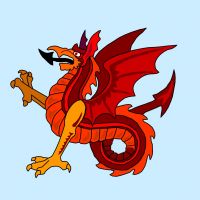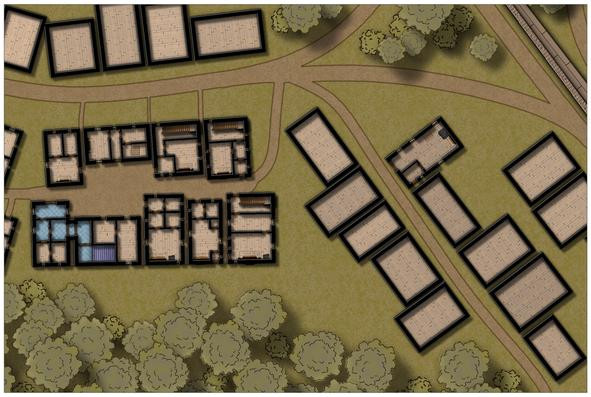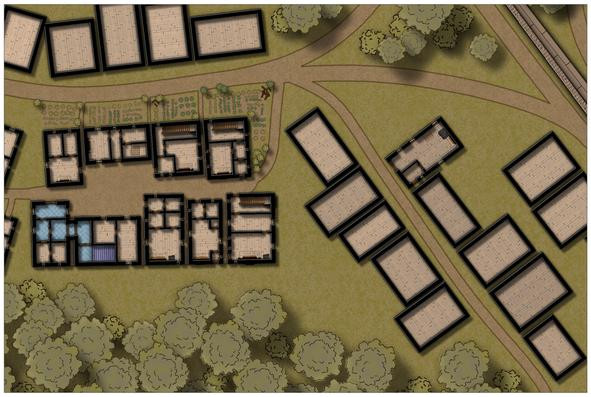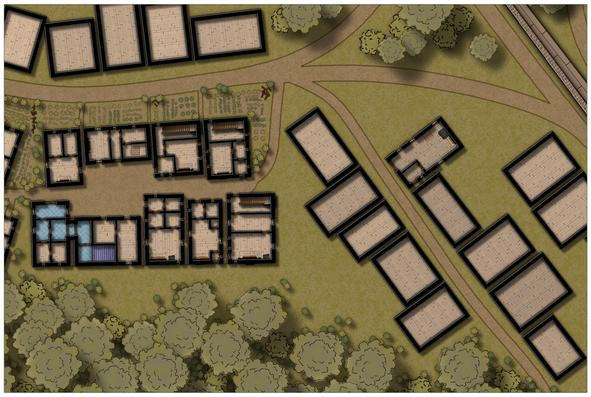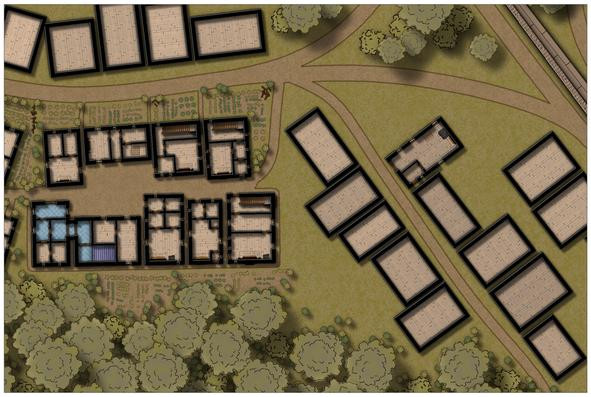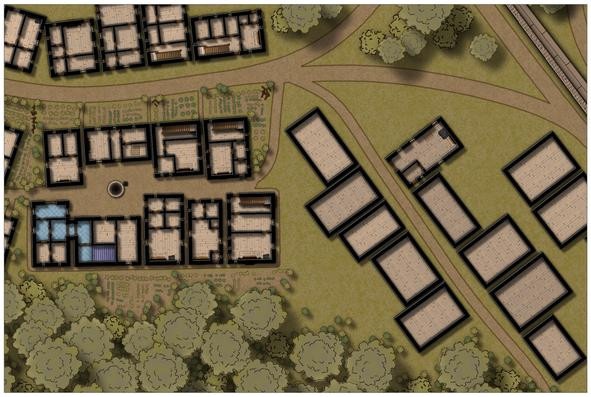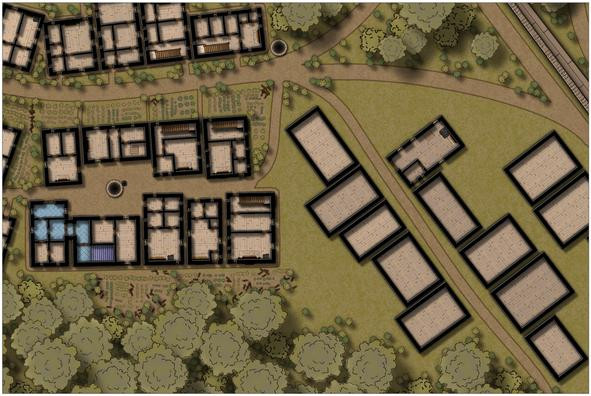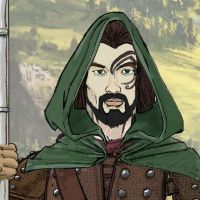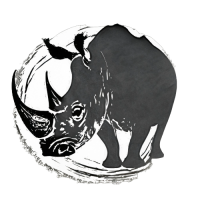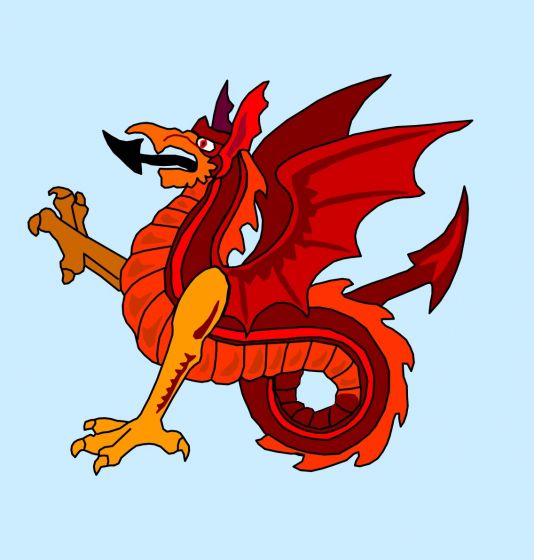
Wyvern
Wyvern
About
- Username
- Wyvern
- Joined
- Visits
- 3,125
- Last Active
- Roles
- Member
- Points
- 5,360
- Rank
- Cartographer
- Badges
- 24
-
[WIP] The Candle & Kettle Inn in the village of Mapleford
-
[WIP] Community Atlas: Temple of Nidag, Stormwatch, Emerald Crown Forest, Alarius
As expected last time, progress has been slow over the past week, much of it only over the weekend. Things have moved on a little though!
First was filling-in more of the internal structural elements in the properties alongside those done so far (including the two partial houses on the left map edge). While doing that, it seemed obvious to fill-in the narrow alleyways between the buildings with a dirt-path fill, given they're likely to see little to no sunlight, and it followed it would be natural to continue those to the closest trackway as well:
Probably hard to tell at this resolution, but the alleys between the eastern properties have been similarly filled, including that blind alleyway at the conjoined temple buildings. Plus a somewhat broader pathway has been added to the front door of one house on the extreme left map edge.
The divisions created by the new alley paths to the main track were starting to look like garden plots, so that's what they became:
It would be natural for areas of land to be used for growing small-scale crops by each property, given the brief summers at such a latitude as this (58°N), much as crofters do in parts of northern Scotland still today, for example, with small amounts of livestock, and land used to grow crops for the family. As I've opted for a summer view of this area, it was always going to be necessary to add extra ground-surface details that the long winter snows would conceal at other times. Thus it followed there'd be more small bushes elsewhere as well:
While I wanted to add some further garden plots east of the central houses too, the proximity of the forest there meant the land would likely be poorer-quality, and so the plots were made deliberately patchier and less filled with greenery:
All of which was starting to make that new "square" between the southern properties look a little sparse, so a well was added, and then the interiors for the peripheral properties further west:
Along the way, I'd also started adding loose "pathways" immediately around the western houses, as marking naturally cleared spaces adjacent to the properties, created through use and for general maintenance, and although I went on to add more, and alleyway-fills, around the western-fringe buildings too, together with more shrubs, and a second well, I haven't got round to adding them yet to those houses with the first gardens, as this last shot for now illustrates:
I did though remember to add more of the bundles of sticks available in this mapping style to the scrubby eastern gardens, to make them a little more unkempt. As mentioned previously, these maps have a tendency to grow organically, as forgotten things get added at random intervals later!
Hopefully, somewhat faster and further progress to follow.
-
Possibilities for recreating the Itiner-e Roman Roads map in CC3+ or other software?
The problem my colleague was having after importing the JSON file into QGIS (free software) was that just the roads showed up. I was vaguely assuming that at least some of the available GIS software would have the topographical geoid data pre-loaded, but maybe that's not the case? I'm approaching this from the perspective of having no idea about GIS software in general though! Is there, for instance, a set of said topographical data available that could be imported into a program such as QGIS, over which the roads could then be overlaid?
In answer to Marja's point, judging by the discussion from 2023 on this Forum my first post here linked to, GIS data can't be directly imported into CC3+ or FT3, so could only be imported as an image that would then have to be traced.
Incidentally, a further colleague commented on that ancient history forum that it seems for Britannia, the Itiner-e map has used only the roads known and suspected from the original 1955 version of Ivan Margary's monumental work "The Roman Roads of Britain". This is odd, because there was an updated version published that expanded and corrected the earlier edition in 1973. I'd already expressed concern on that other forum, because I'd found at least two roads known to exist in Scotland that aren't on the Itiner-e map. In addition, it seems the Itiner-e map has excluded at least some British Roman Roads that don't connect into the rest of the network, despite the fact they're archaeologically attested. This could mean there are similar problems elsewhere, of course, for all it remains a fascinating resource map.
-
A Monastery by the Sea
Often, shadowing problems like this can be improved by softening the appearance of the shadows, to make them more subtle (increased transparency, reduced size, altered colouring, adjusted blurring are all possibilities).
The bridge shadow's showing an odd gap, and its presence illustrates that a shadow effect stacked on another one starts to look odd - the bridge is further from the sea than the cliff bases, yet its shadow is more distinct, for instance.
One option to escape that double-shadowing trap might be to use the existing shadow effect lines and areas to redraw the shadow as a separate polygon, and then turn off the shadow effects entirely. Using one of the "Solid" bitmap fills might work for this, or just a normal darker grey polygon with a suitable transparency effect.
There's also the possibility of adding some extra shadow effects to the little rocks in the sea, as they currently don't have any shadows, which makes them look a little odd where they're exposed to the light. If they're all only low-lying rocks though, they'd cast negligible shadows from this viewpoint anyway, so that may be a shadow effect too far 😉.
-
Looking for ships wheel png
You could simply draw your own, using polygons of the wooden bitmap fills in the Sailing Ship Annual (CA27). There are some odd symbol omissions from that Annual issue in general, which could perhaps be remedied by a future updated version (pretty please!) 😊.


